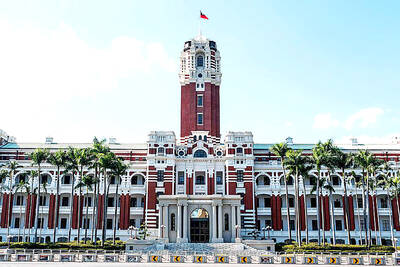South Korea's first bullet train goes into service this week promising to transform people's lives by easing chronic traffic congestion.
After 14 trillion won (US$12 billion) of investment and years of delay caused by the 1997 Asian financial crisis and major engineering obstacles, the 300kmh train will open for business on Thursday on two lines linking Seoul to Busan in the southeast and Mokpo in the southwest.

PHOTO: AFP
The construction of the new rail system, dubbed Korea Train Express (KTX), is considered a seminal national event here, on a par with the completion of South Korea's first highway from Seoul to Busan, 428km south, in 1970.
Many more highways have been added since then, but road-building was overtaken by the number of vehicles in the intervening years, leaving South Korea's transport costs among the highest in the world.
Kim Se-Ho, head of the state-run Korean National Railroad (KNR), said KTX would bring about "revolutionary changes to logistics and people's lives."
"By mixing KTX with other means of transportation, you can reach anywhere in the country within a half day," he said of the French technology-based bullet train.
Lifestyles will improve as people abandon congested cities for the countryside in search of cheaper rent and clean air and residents in provincial cities will be able to shop and see art performances in Seoul, he said.
Commuters will take 49 minutes travelling by train between Seoul and Daejeon, some 160km south, while motorists sit behind the wheel for more than an hour to reach downtown from the outskirts of the capital.
KTX covers the whole 410km run from Seoul to Busan in 160 minutes although it has to slow down on old tracks used by conventional trains.
The fastest conventional train covers the same distance in 240 minutes.
When the old tracks yield to new railbeds in 2010, the travel time will be cut to 116 minutes.
In its first year of service, KTX is expected to carry 180,000 passengers per day, enabling the Korean National Railway to cut back on slower services to free up those trains for cargoes.
Experts said the costs of road traffic congestion in South Korea have been increasing 13.5 percent on average over the past 10 years to hit 22 trillion won in 2002.
It amounts to 3.7 percent of the country's total GDP.
"KTX is equal to four Seoul to Busan highways in terms of logistics capacity," Kim said, adding that KTX will save the country 1.85 trillion won in logistics cost next year alone.
Aside from logistical gains, the new railway system brought a leap forward to South Korea's railway technology.
KTX will operate 46 sets of trains, 12 imported directly from Alstom of France and 34 others were assembled here.
With technology transfer from Alstom, KNR has successfully developed its own model, the G7.
"We plan to increase G7's speed to 350 kilometers per hour," Kim said, adding that South Korea seeks to export this model.
KTX recently took a group of diplomats and journalists on a test driving to Daejeon. The sleek silver-grey and blue train hit 307km at one point but passengers reported slightly more rolling and noise than the France's TGV high-speed train.
Acting President Goh Kun expressed hope on Wednesday that KTX would help South Korea emerge as a railway hub on the "Iron Silk Road" linking Northeast Asia and the Pacific to Europe.
"My dream is to travel to Pyongyang and all the way across Siberia to Europe by this high-speed train," Kim said.

The CIA has a message for Chinese government officials worried about their place in Chinese President Xi Jinping’s (習近平) government: Come work with us. The agency released two Mandarin-language videos on social media on Thursday inviting disgruntled officials to contact the CIA. The recruitment videos posted on YouTube and X racked up more than 5 million views combined in their first day. The outreach comes as CIA Director John Ratcliffe has vowed to boost the agency’s use of intelligence from human sources and its focus on China, which has recently targeted US officials with its own espionage operations. The videos are “aimed at

STEADFAST FRIEND: The bills encourage increased Taiwan-US engagement and address China’s distortion of UN Resolution 2758 to isolate Taiwan internationally The Presidential Office yesterday thanked the US House of Representatives for unanimously passing two Taiwan-related bills highlighting its solid support for Taiwan’s democracy and global participation, and for deepening bilateral relations. One of the bills, the Taiwan Assurance Implementation Act, requires the US Department of State to periodically review its guidelines for engagement with Taiwan, and report to the US Congress on the guidelines and plans to lift self-imposed limitations on US-Taiwan engagement. The other bill is the Taiwan International Solidarity Act, which clarifies that UN Resolution 2758 does not address the issue of the representation of Taiwan or its people in

US Indo-Pacific Commander Admiral Samuel Paparo on Friday expressed concern over the rate at which China is diversifying its military exercises, the Financial Times (FT) reported on Saturday. “The rates of change on the depth and breadth of their exercises is the one non-linear effect that I’ve seen in the last year that wakes me up at night or keeps me up at night,” Paparo was quoted by FT as saying while attending the annual Sedona Forum at the McCain Institute in Arizona. Paparo also expressed concern over the speed with which China was expanding its military. While the US

SHIFT: Taiwan’s better-than-expected first-quarter GDP and signs of weakness in the US have driven global capital back to emerging markets, the central bank head said The central bank yesterday blamed market speculation for the steep rise in the local currency, and urged exporters and financial institutions to stay calm and stop panic sell-offs to avoid hurting their own profitability. The nation’s top monetary policymaker said that it would step in, if necessary, to maintain order and stability in the foreign exchange market. The remarks came as the NT dollar yesterday closed up NT$0.919 to NT$30.145 against the US dollar in Taipei trading, after rising as high as NT$29.59 in intraday trading. The local currency has surged 5.85 percent against the greenback over the past two sessions, central